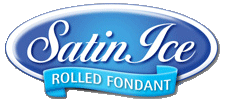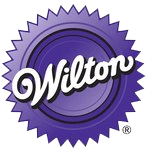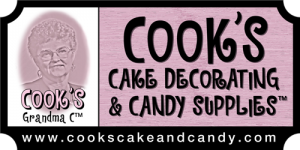Cake Decorating
Grandma C knows that "cake decorating is a creative art and a passion." To have your cake be the appealing work of art that you envision, you must first understand the techniques and the materials needed to make your decorating experiences be successful and satisfying.
As you plan your cake, you will most likely be choosing from the 3 most popular cake types. You will find help on techniques, equipment that will make your efforts easier and examples of cakes that might help to inspire you!
Below are a few examples of cake types with helpful information that includes:
- Techniques and Directions - to save time
- Examples of Cakes - for inspiration
- Products You Need - to make your job easier
- Recipe Suggestions - delicious!
Tier Cakes
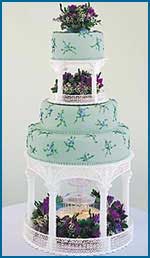 When making a tier cake, you will want to use pans that are straight sided. This will produce a cake tier with nice, straight sides. The various tiers will line up properly and look straight (do not use pans that have slanted sides). Cake pan sets that stack inside of each other are your best choice.
When making a tier cake, you will want to use pans that are straight sided. This will produce a cake tier with nice, straight sides. The various tiers will line up properly and look straight (do not use pans that have slanted sides). Cake pan sets that stack inside of each other are your best choice.
Tier cake pans come in Rounds, Squares, Petals, Ovals, Hearts, and Hexagon sets. Most sets have 3 or 4 sizes. They are made so the sizes are complimentary to making tier cakes for most any occasion.
Tier cakes can be set up on cake stands or tiers can be stacked on each other. Stacked cakes must be properly doweled, to keep the upper tiers from crushing the lower cake tiers.
Sturdy baseboards, ruffle boards, cake ruffles, separator plates and pillars are available for setting-up and supporting tier cakes. Tier cakes can use either a 1-plate system with “push- through” pillars or a 2-plate system with “set-on” pillars and doweling.
To help in planning your tier cakes, in addition to the many books we offer to illustrate different tiered cake styles and examples, we have styrofoam dummy cakes that can be stacked to give you a visual representation of the look you want to attain with your final cake design.
Flat Cakes
 Flat cakes can be made in any variety of pans. Round, Square, Rectangle, Cookie pans, Character pans, Sheet pans and Disposable Foil pans.
Flat cakes can be made in any variety of pans. Round, Square, Rectangle, Cookie pans, Character pans, Sheet pans and Disposable Foil pans.
To determine the amount of batter you will need for a particular pan, place the pan on a level surface.
-
Fill pan with water to the top - measuring the amount of water used.
-
Now divide that amount in half. This would be the amount of batter needed.
Character pans need both the sides and bottom greased and floured to get the cake to turn out. If you get a dome on a cake baked in a character pan. As soon as cake is done and removed from oven, place a clean towel on a cake rack and place on top of the cake in the pan. - Press down lightly to even the cake to the top of the pan. Then when you turn out, that slight dome will be on the bottom and should not give you a problem.
Flat cakes baked in thin layers, filled and stacked 2 or 3 layers - then frozen - cut in small shapes, makes for easy Petit Fours.
3D Cakes
-
 When baking a 3D style cake be sure to follow pan instructions carefully. Be sure to save and protect those instructions so you will have them for next time (copies are not available).
When baking a 3D style cake be sure to follow pan instructions carefully. Be sure to save and protect those instructions so you will have them for next time (copies are not available). -
Use a firm cake (like a pound cake) when making a 3D cake.
It is not advisable to use chocolate cake recipes, as they are usually very moist and often will not hold up for the firm shape you will need.
-
All parts of a 3D pan must be greased and floured to make sure cake releases.
-
3D pans that have a baking core. To be sure you have it for your next cake, do the following:
-
After cake is cooled, remove core. Replace it with a styrofoam cup that has been cut to fit the opening. Stuff the cup with foil and then also wrap the cup with foil. Next, put it in the opening where you removed the core. This will stabilize the cake and you will not loose the core if you are taking the cake to an occasion away from home.
-
Retail Store Hours:
Monday through Friday
10:00 am - 5:30 pm
Thursday
10:00 am - 7:00 pm
Saturdays
9:00 am - 1:00 pm
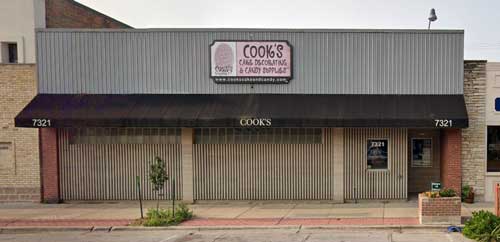
7321 W. Greenfield Ave.
West Allis, WI 53214
Order Online or
Call Ahead for Pick-Up
414-257-0055



